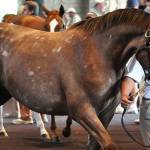A Quick Guide To Horse Sales

Public auctions are age-old venues for buying and selling horses. Whether it’s a weekly sale at the local stockyards where children’s ponies find new friends or a revered Thoroughbred sale where racing’s future stars change ownership, horse sales are commonplace the world over.
If you’re in the market for a horse, auctions offer a slew of horses to choose from. Novice horsemen should seek guidance from an experienced individual if you’ve chosen a sale to purchase a new horse.
For those unfamiliar with sales, fluency in sales-talk will heighten the experience. The following terms will provide a jumping-off point for your sales adventures. To get a real feel for the auction atmosphere, you will have to attend a few.
Terms to Know
catalog—at larger sales, horses are listed numerically by hip number (see below) in a sale catalog. A description of the horse will usually include the year foaled, color, gender and pedigree. Some sale catalogs will include a detailed ancestry that includes performance statistics. Depending on the type of sale, the owner or consignor (see below) of the horse may have the opportunity to include a more elaborate description of the horse.
Coggins test—written proof from a veterinarian that a horse has been tested for equine infectious anemia (EIA). A negative Coggins test is usually a requirement before a horse can gain admittance to a sale, though not always. If a horse does not have a negative Coggins test at the time of the sale, an on-site veterinarian might draw blood and send it for testing. In case of an outbreak of EIA, this helps track the whereabouts of infected horses.
consignor—the individual that arranges for the horse to be sold at the auction. The consignor is sometimes the actual owner of the horse but may also be an agent for the owner.
cribber—a horse that engages in a stable vice in which it hooks the incisors to a stationary object, pulls back, and emits a grunting noise. Many horsemen find the trait undesirable because passionate cribbers will sometimes rather crib than eat, which makes keeping weight on them difficult, and wear and tear on wooden structures can be extensive. Certain sales companies make consignors reveal to potential buyers if horses are cribbers.
cryptorchid—a horse with at least one undescended testicle. Certain sales companies make consignors reveal to potential buyers if horses are cryptorchids.
hip number—horses usually sell in a predetermined order. In the case of large sales, the number was likely decided upon when the catalog was being created. A sticker with the horse’s order of sale is placed on the horse’s hip, corresponding to the catalog number.
out—a cataloged horse that is removed from the sale by the consignor.
no-sale—the horse was brought into the sale ring but bidding did not advance sufficiently to meet the consignor’s minimum price or reserve (see below).
repository—at the largest sales, particularly those of Thoroughbreds and Standardbred racehorses, a collection of radiographs of every young horse is available for review by veterinarians.
reserve—a minimum price for which a consignor is willing to sell a horse. Some horses sell without reserve, so the final bid by a potential buyer is the winning bid.
RNA – short for “reserve not attained,” is another way of indicating a no-sale (see above).








